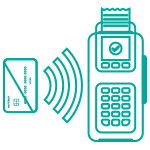Point of Sale systems is an indispensable tool for both the retail and restaurant industries. Businesses once utilized individual spreadsheets to keep a record of their transactions and payments, monitor inventory, and keep track of their expenses. But spreadsheets and paper-based records are cumbersome and excessively prone to human errors, manipulation, theft, and loss.
The introduction of POS systems allowed users, particularly in the retail and restaurant sectors, to consolidate all data regarding their transactions, inventory, operational expenses, delivery schedules, and more. By having a single platform to centralize all critical business processes, information, and functions, users are able to streamline their functions, enhance efficiency, and most importantly, focus on their customers.
Today, with the advent of mobile technology, the cloud, artificial intelligence, and more, the value of POS software has gone up drastically. Retail stores and restaurants are no longer tethered to static workstations and counters. Users have become more agile and flexible, able to cater to their customers and provide them with experiences in ways that desktop-based applications and fixed counters can’t offer.
As the usage of modern and cloud-based POS solutions is gaining significant ground, the average POS software price is becoming more competitive and affordable. As technologies continue to evolve and disrupt industries, it is very interesting how the POS is faring and adapting to remain a significant and valuable solution for modern-day enterprises.

1. Customers Prefer Cashless Payments
The use of mobile wallets and digital cash is no longer limited to online purchases. People are now ditching actual cash and use digital money to pay for products, food, and services even in brick-and-mortar stores and physical establishments.
The increasing use of smartphones, along with the constantly growing number of smartphone users, adds fuel to the increasing popularity and adoption of cashless payments via mobile devices. A 2019 eMarketer article reported that 36.3% of smartphone users settle in-store purchases via mobile payments once every six months.
Such is the prevailing scenario, especially among modern, tech-savvy customers. CurrencyPay.com cited in its 2019 post on cashless payments that security, mobility, convenience, and spend control are the main factors as to why consumers prefer to pay via digital means instead of actual cash.
Retailers and restaurants will be the most affected by this trend. As such, it is critical for them to consider investing in a retail or restaurant POS system in addition to their existing conventional cash registers to address this expected change and meet head-on the consumers’ demand for cashless payments.
2. Immense Popularity of Mobile-Based POS
Cashless payments are becoming prevalent, the world is still far from becoming a completely cashless society. That said, the world is now totally mobile. From a POS perspective, that means customers are able to Pay wherever and whenever through their mobile devices.
Why bring along a bulky retail POS equipment to a site and waste precious time and resources setting it up when you can accept payments quickly and easily using your smartphone or tablet? A retail business that peddles products in locations other than their stores, such as conferences, festivals, and conventions, can capitalize on this trend by getting a mobile-based retail POS system.
The same can be said with players in the foodservice industry like restaurants, bars, cafes, coffee shops, and other similar establishments. Restaurants can reach out to their customers via mobile food trucks and manage their kitchen via a mobile or cloud-based POS.
In the United States alone, the outlook for mobile POS payments is expected to go skywards in the next three to four years according to Statista. Mobile POS payments will account for over $116 million in revenue in 2020. By 2023, that amount will increase to approximately $246.77 million, representing an impressive CAGR increase of 28.6% within a very short forecast period.
It’s high time for business enterprises to realize and acknowledge that POS mobility is a big game-changer, particularly in the retail and restaurant sectors. Looking at the best mobile POS system for sale is a start.
3. POS Data to Create Personalized Experiences
Personalization is vital to retail and restaurant operations. But creating and delivering a personalized experience can be quite hard, especially when your business caters to a large customer base comprised of individuals with different personalities, wants, and needs.
Still, your customers expect you to know what they want or need, long before you contact and engage them. In fact, 51% of today’s consumers expect companies to anticipate their wants and needs and offer significant recommendations prior to initial contact, according to Salesforce’s State of the Connected Customer Report.
So how do POS platforms play a role in the personalization of marketing approach and customer experiences? Apparently, the best POS systems track and gather useful data such as previous purchases, shopping behavior, customer trends, in-store analytics, and more.
You can feed all this information to a data analytics solution and generate actionable insights to help create profiles per customer and determine customer groups/segments based on a number of variables such as age, location, gender, previously purchased products, products recently viewed, and more.
With such insights available to you, you can create and share personalized promotions, product recommendations, branded messages, and other marketing materials that resonate with your customers. Thus, it increases customer engagement and drives customer loyalty, which impacts your business revenue and growth positively.
Keep Watch for Other POS Trends
Cashless payments, POS mobility, and data analytics are not the only trends that fuel the POS revolution. Other innovations and emerging technologies like the cloud, artificial intelligence, and social media shopping are also coming into play and impacting the POS industry. Businesses should keep a close on other POS trends if they want to remain significant, competitive, and ahead of the curve.
IVEPOS is an all-in-one Android-based POS system for both retail and restaurant. It is also equipped with billing and ERP tools to further streamline your processes. To get an overview, check out this expert’s review of IVEPOS and learn more about its features and benefits.






![What is Stock Audit? [How to Perform It & Its Advantages]](/wp-content/uploads/2022/12/Blog_Image_700x400_68-500x383.jpg)


![How to Start Catering Business [Ideas, Plan & Item List]](/wp-content/uploads/2022/09/8b78cc_08060cb445e048ecb631cb39802cb5f7_mv2-500x383.webp)
Leave A Comment